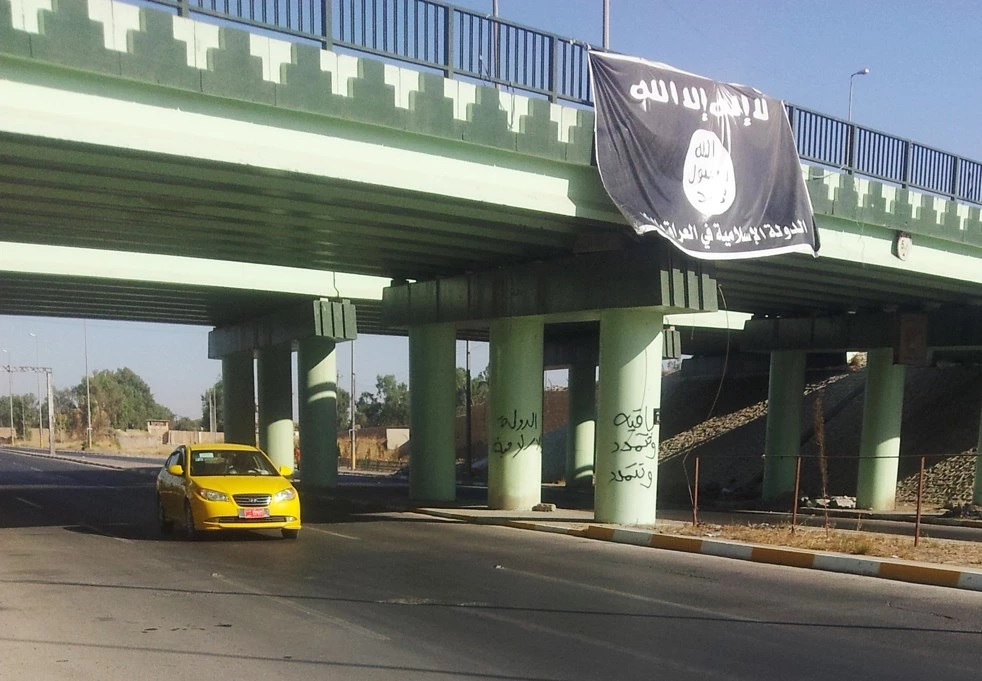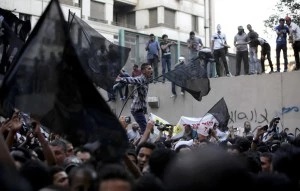
Friday, August 15, 2014

A motorist drives beneath a flag of the Islamic State at the entrance of the northern Iraqi city of Mosul.
The black-and-white banner is not only being flown in Iraq and Syria, where the group has claimed a "caliphate," but also in London — and now, apparently, New Jersey and outside the White House.
Mark Dunaway — a Garwood, N.J., resident who converted to Islam about 10 years ago — seemed to have no idea that the flag he was hanging outside his house was associated with a violent militant group that's on the march in the Syria in Iraq.
"I hang it every Friday and every Ramadan which ended not too long ago and I keep it up a little longer than I normally do," Dunaway told FoxNews.com. "I guess some people saw it and got offended so I took it down. I do not support any militant group or anything like that."
Dunaway removed the flag from the front of his house, replacing it with one for an American football team, the San Diego Chargers, according to NJ.com.
"I understand now that people turn on CNN and see the flag associated with jihad, but that's not the intention of that flag at all," Dunaway told NJ.com. "It says 'There is only one god, Allah, and the prophet Muhammad is his messenger.' It's not meant to be a symbol of hate. Islam is all about unity and peace. I am not a part of any group like that, and I'm not anti-American. I love my country, but I am a Muslim."
Dunway did not respond to requests for comment on Thursday and Friday.
Putting aside the question of whether he had ever heard of the Islamic State or seen the flag flown in photos accompanying dozens of media reports in recent years, the real history of the flag is fairly recent and inextricably linked to jihad.
So how does an unsuspecting New Jersey man end up with a flag associated with a brutally violent militant group? Well, for one thing, you can buy the Islamic State's flag on eBay for a mere $20, as of this writing.
And if you weren't following the news closely, the flag's use of seemingly generic religious imagery might fool you.
An image taken from a 2013 video uploaded on YouTube allegedly shows a member of Ussud Al-Anbar, a Jihadist group affiliated with the Islamic State, holding the trademark black-and-white flag in Iraq's Anbar province.
At the most basic level, the flag's black background is supposed to represent the black banner believed to have been carried by Mohammed himself during his expeditions and battles, according to Christopher Anzalone, a McGill University PhD candidate who closely studies militant Islamist groups.
That flag was essentially blank and is not believed to have had any sort of calligraphy printed on it.
The flag currently used by the Islamic State and its sympathizers, however, includes several inscriptions.
 Kashmiri demonstrators hold up Palestinian and Islamic State flags during a demonstration against Israeli military operations in Gaza on July 18. |
 Egyptian protesters — some carrying makeshift Islamic State flags — climb the walls of the U.S. Embassy in Cairo on Sept. 11, 2012. |
"The use of the testament of faith is just to emphasize that all Muslims should identify as just Muslims first rather than any sort of national nation-state identity," Anzalone said.
According to Anzalone, use of that statement on a black or even white flag dates back decades — long before the advent of the Islamic State. For example, Hizb ut-Tahrir, an Islamic political group, uses a black-and-white flag that simply has the testament of faith in large letters across it.
The Islamic State adds a second element to its version of the flag: a circular inscription in the center that translates to "Mohammad is the messenger of God."
The inscription is written in an archaic calligraphy style. Instead of being read from top to bottom, it is read from the bottom to the top. That's because it is designed to mirror the pattern of a ring Mohammad used to sign his letters — a replica of which is on display in a museum in Istanbul.
This version of the flag, with the testament of faith and an imprint of Mohammad's signet ring seal, has been used with slight variations by a slew of different jihadist groups over the years, Anzalone said.
In 2006, shortly after the death of Abu Musab al-Zarqawi, the founder of the Islamic State's precursor organization, the group began using the black-and-white flag which which it is now closely associated.
Other groups such as al-Qaeda in the Arabian Peninsula and al-Shabaab, based in Somalia, all began using similar versions of the flag subsequently. All three groups are designated as terrorist organizations by the United States.
A makeshift version of this same flag was hoisted above the U.S. Embassy in Cairo in 2012 and has been spotted in Kashmir, near the Syrian-Turkish border, and in other parts of the Muslim world.
In some versions, an inscription at the bottom of the flag is specific to the Islamic State. That text translates to various iterations of the group's name – The Islamic State of Iraq; the Islamic State of Iraq and al-Sham; or simply, the Islamic State.
It shows up in propaganda photos, videos and social media postings, probably, Anzalone suggests, as part of the group's well-documented campaign to spread its message far beyond Iraq and Syria."There does seem to be in the video materials and photographs an even higher emphasis on the flag being used as a kind of ideological prop," Anzalone said. "It could also be related to the sheer volume of propaganda material that the Islamic State produces."